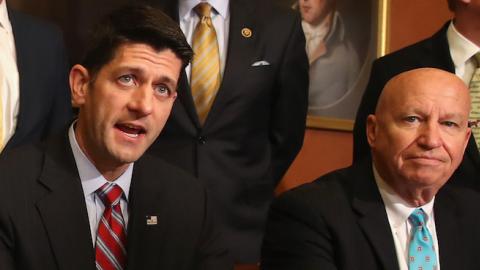One of the most important reasons for the success of Donald Trump's presidential campaign was his pledge to bring back manufacturing and the good paying jobs it offers to the disintegrating families and communities in the American heartland. But crafting a policy to accomplish this has raised concern in both the United States and abroad of an attack on the Bretton Woods consensus. A robust tax-reform package along the lines of the Ryan-Brady House Blueprint recently developed in the House of Representatives would be key to delivering on Trump's promise. It would also go a long way to reducing the chronic trade imbalance that has drained the strength of the industrial sector, while limiting the possibility of a trade war.
Trump's use of the bully pulpit and his early deregulatory initiatives have already rejuvenated the economy's animal spirits, which had been dampened by the Obama administration's neglect of pro-growth policy and the persistent global economic weakness that characterized the Obama-era. During the Obama years, a lack of confidence was reflected in chronic weakness in capital investment. High corporate tax rates in an era of aggressive global tax competition also made it attractive for capital-intensive, trade-oriented sectors such as manufacturing to move production abroad.
Confidence in the domestic economy can only be sustained if the structural incentives in the tax code are eliminated permanently. When combined with a lighter regulatory hand, tax reform can solidify the ongoing reversal of the cost disadvantages facing domestic manufacturing. This trend has been chronicled in research by the Boston Consulting Group and others, showing that managing the costs and improving the comparative productivity of domestic manufacturing has significantly narrowed the cost gap with competitors, including China.
There are three main elements of the Ryan-Brady plan that would give a major boost to the industrial sector: (1) lowering the top corporate income tax rate to 20 percent (and capping income taxes on the pass-through corporations, which are vital innovators in manufacturing and technology, at 25 percent); (2) moving to first-year expensing of capital investments; and (3) adopting the border adjustable, territorial tax system.
Most U. S. competitors have lower corporate tax rates that are only applied to sales within their own countries. They also rebate value added and other indirect taxes on their exports. These features have incentivized many U. S. firms to move production abroad and, increasingly, to reincorporate in tax-friendly locations. Additionally, profits made by U. S. firms either through exporting or producing abroad are frozen in offshore accounts due to the high taxes incurred when repatriating those profits. This erodes the domestic tax base in addition to sapping jobs, research, and business for related finance and transportation providers resulting from domestic industrial production.
Adopting both a regime of lower taxes and a territorial system would help eliminate the advantages of moving production abroad and, in conjunction with deregulation, encourage a domestic revival. The border tax would at a minimum raise over $1.2 trillion dollars to help pay for a reduced rates and full expensing. It would also encourage repatriation of profits held abroad both to fund new investment and to pay for lower tax rates on business. Although economists disagree on the impact the border tax would have on trade flows, it is likely that it would add some incentives to domestic production, at least in early years. Market responses could eventually raise domestic prices, but this could be offset by dollar appreciation, according to Martin Feldstein and Robert Barro. Moreover, the "forgotten" people who would gain steady and well-paying new jobs in the industrial sector are likely to value these jobs more than the cheaper price of consumer goods.
But the principle attraction of a border tax is helping to pay for the clear growth enhancements and new investment from expensing and lower rates. The Tax Foundation model predicts that the Ryan-Brady plan would increase long-term growth by 9 percent, wages by 7.7 percent, and generate 1.7 million jobs.
The politics of tax reforms and border adjustments are undoubtedly very complex. Industries, such as oil refining and some retail, and self-appointed consumer advocates will sound the alarm against a border tax. But it would be wise to keep in mind the role of such policy shifts as a linchpin for achieving higher growth and a return to domestic production. Self-sufficiency in North American oil production is achievable, and oil and gas, including refined products -- a growing source of export strength -- would be accelerated. Domestic production of consumer goods, such as electronics, is also conceivable with this new tax regime. And the customers of retailers -- especially mass market retailers -- are the workers who operate the resource production and manufacturing sectors. They would certainly benefit from the better jobs prospects of a higher growth economy.
Finally, achieving some rebalancing of trade and investment flows as well as leveling the playing field with border adjustments would help obviate the need for unilateral tariffs or other trade measures that could well lead to mutually destructive trade wars.



















